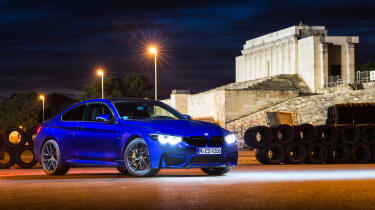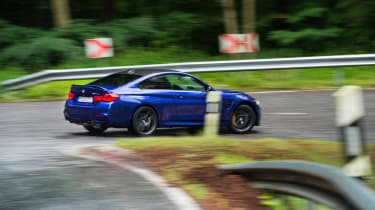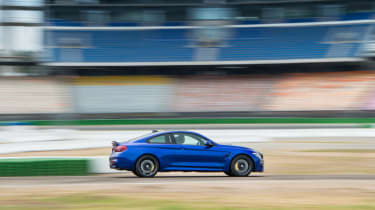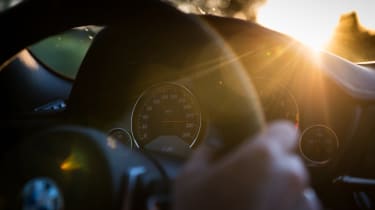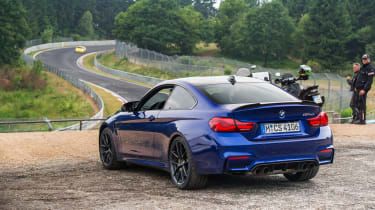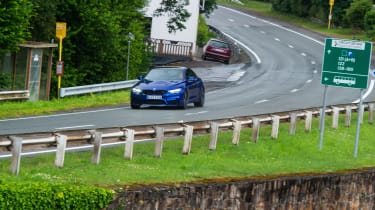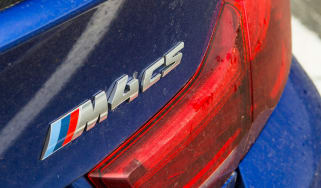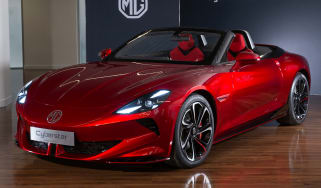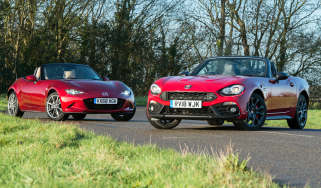BMW M4 CS (F82) in-depth test: the ultimate M road trip
We took the BMW M4 CS on an epic European road trip, stopping off at iconic motorsport landmarks along the way
The gruff, grating bark rises to a domineering pitch. Just 20 minutes ago we extracted the M4 Club Sport from the eerie silence of its hometown press fleet lair – all deserted, dimly-lit corridors on a sunday afternoon, clammy bunker-like warmth cloaking neat rows of pristine BMWs ready for collection in stifling silence. Now, as we head north from Munich on the A9 autobahn, the traffic is light, the road dry, conditions perfect.
Without the synthetic drone of the artificial noise generator the ‘six’ at last sounds like an actual internal combustion engine, with hints of the S50 from the E36 M3, the volume almost oppressive thanks to the CS’s freer-flowing exhaust. Time to get going for real. Past 120mph. Past 140, 150, 160. Past 170mph, still with vigour. And finally, right there, a deft, barely perceptible lurch betrays the speed limiter at 174mph. With the finely poised balance of a ballerina rising up on the toes of one foot, the CS enters the final phase of its aerodynamic envelope. At 160mph it was assured, but the persistent battering of the airflow around the body now makes it edgy, the response of the steering perceptibly lighter and less accurate, and mild curves become genuine corners. This, in spite of the CS’s bespoke carbon fibre front splitter and coquettish gurney flap on the boot lid reducing lift. Every input I make is the slowest, weakest, smallest I can get away with. Concentration is all-consuming. As the low sun refracts alarmingly across the CS’s windscreen the 100 miles between Munich and Nuremberg disappear indecently quickly.
Earlier, I’d been wondering if the M4 CS is a real M car in the sense that you and I love to picture them. Efficient brilliance, hard-as-tungsten, but with a Stein-swilling sense of hooliganism just below the surface that often leads to smoking Michelins. It’s only in the last few months, with the advent of the 2018 Model Year Competition Package specification, that the M4 has found our favour. Now it’s the CS’s turn, and bringing it back to the UK via as many racing circuits connected with the BMW marque as possible should provide us with some answers.
It’s dusk when we reach the outskirts of Nuremberg, and we’ve nearly drained the fuel tank in one sitting. Pitifully, my wallet braces itself for the first of a repeated bashing on the forecourts of Aral and Shell. We’ve come to Barvaria’s second biggest city to visit the Norisring: a street circuit unlike any other, it resides to the south-west of the city centre and its history is anything but orthodox. Simplistic in layout, its 1.4-miles of long straights and just eight corners, laid out on the former Nazi party Zepplinfeld parade grounds, with the towering Steintribune and central podium where Adolf Hitler addressed the massed crowds in the 1930s at its centre. Originally part of a complex of grounds and buildings on a site over four square miles in size, the project was one of the first for Hitler’s architect Albert Speer and was never completed.
Racing actually began here as early as 1947, and over the years the track has become an instantly recognisable part of German motorsport culture, with big crowds crammed into the grandstands watching single-seaters and top-level sports cars. But it’s the rough and tumble of the DTM (the German Touring Car Championship) – sometimes racing four-abreast on the wide expanses – that’s perhaps most closely associated with the place, particularly in its late 80s-early 90s pomp. Take 1987, when a certain Olaf Manthey, now of Porsche racing team fame, won in his E30 M3, with the M3s of Marc Hessel second and evental season champ Eric Van De Pole sixth.
It’s those screaming little M3s that I picture as we pad around the lonely circuit tonight, letting the CS run wide at the exit of the Scholler-S chicane so that the front wing nearly grazes the concrete wall – it’s not unknown for DTM drivers to often brush the unyielding concrete while seeking that last tenth or two. Past, too, the small memorial for racing legend Pedro Rodriguez, who was killed on this stretch of the track when the privateer Ferrari 512M he was driving that weekend in 1971 hit the barriers at speed and exploded.
It’s tricky to define, but there’s an uncomfortable, chilling atmosphere at the deserted Norisring that makes me zip my jacket right to the collar and look forward to leaving as soon as we can. This is a place where great evil was unquestionably present, and the sense of it in the darkness is profoundly unsettling.
I’d like to tell you something interesting about the journey to Hockenheim the next day, but it soon becomes clear that the slog westwards will be one long traffic congested chore. The CS rides with the same taut but carefully defined movements that make the Competition Pack M4 a surprisingly biddable companion, even if the featureless slab of lightweight door card and simplified centre console mean there’s very little storage space for all the road trip usuals. The CS is effectively a further round of honing on top of that Competition Package. It shares the same excellent chassis, although the adaptive dampers and electro-mechanical steering have both been reprogrammed, largely to take into account the new Michelin Pilot Sport Cup 2 tyres. They’re fitted around lightweight forged rims that banish in one stroke all that naff ‘diamond cut’ thing for a proper motorsport aesthetic. Apart from its aforementioned aerodynamic addenda there’s a new bonnet with a pronounced power dome and a larger vent slashed into the front: it’s made from CFRP and is 25% lighter, so BMW says. All-in the CS is 32kg lighter than a regular M-DCT-equipped M4CP, so not a massive saving but worth having all the same. Shame you can’t get one with a manual ‘box.
Hockenheim is one of those circuits with an indefinable air of former glories. While still an active F1 circuit, it’s never been the same since the giant loop into the dense forest was closed, and the track redesigned by that hate figure of circuit design, Hermann Tilke, in time for the 2002 German Grand Prix. Today, if you’re persistent and smile like you know where you’re going, you can drive out to where the old forest loop would rejoin at the stadium section. The arrow-straight strip of tarmac that leads to the horizon is now for ramblers and cyclists, not loud, polluting, 200mph racing cars, with trees and shrubbery closing in relentlessly on all sides. BMW memories? I spend a moment in the silence trying to imagine Hans-Joachim Stuck racing to second place in the 1981 DRM round with his Schnitzer-run BMW M1 turbo, a car that developed as much as 1,000bhp. What I should probably be thinking of is Ralf Schumacher’s victory in the last GP to be held on the old track, in 2001, at the wheel of a Williams-BMW.
Onwards. I’m in a groove with the CS now: the alcantara ‘lightweight’ sports seat so comfortable, my preferred driving modes – comfort for most things to avoid artificial weight, medium engine response, fast but not too harsh gearshift, comfy ride, manual mode – set. Flugplatz Mainz-Finthen makes Bruntingthorpe look like Heathrow in the summer holidays. As the oppressive heat builds in the still Rhineland air I trundle the CS past the preserved American army guard house – a remnant of the facility's post-war life – and carefully pick my way down the rough entry road onto the active part of the airfield. It’s been a short and unremittingly uneventful drive from Hockenheim in a northwesterly direction.
A motley ensemble of meek light aircraft doze silently as they wait for a pleasure or student flight. It’s a far cry from the summer of 1943, when this aerodrome would have reverberated with the roar of Luftwaffe fighter planes tasked with defending the Third Reich against the onslaught of American heavy bombers undertaking mass daylight raids. Their hangar is still here, clinging on but seemingly irretrievably decayed; the silence poignant.
It was also far from silent on the 20th May, 1990, when the DTM arrived. With a relative lack of permanent venues, and burgeoning popularity, the series governing body sought new tracks even if they were entirely temporary. Unlike in Britain, many of Germany’s military airbases were still active or only recently decommissioned in the 1980s, so going motor racing on them was much like racing in England during the early 1950s, with circuits laid out via cones and tyre walls, runways still clearly marked, and parked aircraft visible in the background. 1990 was Audi’s year with its steamroller of a V8 saloon, but not at Finthen, where BMW’s Johnny Cecotto achieved a double race victory in the ultimate 2.5-litre Sport Evolution version of the E30 M3, all 380bhp squeezed out of the venerable 4-cylinder S14 engine.
However, you can’t go on a tour of German racing circuits and not visit the greatest of them all. Getting to the ‘Ring from Mainz is easy, and the final part of the journey provides the sort of roads to at last enjoy the CS’s more dynamic attributes.
The CS offers an extra 10bhp over the CP model, along with – perhaps more significantly – another 37lb ft of torque. That 453bhp in a slightly lighter M4 is more than enough to satisfy, delivered with an unyielding punch but maintaining its enthusiasm as the revs rise. Having said that, as the miles pass, I still miss the old naturally aspirated M engines, and I’d trade the additional performance of the turbo motor for some of that former crispness and fiery top end. There’s the question of intake noise, too: the CS’s engine sounds mighty through the mid range, but its voice never evolves at higher rpms into something more exotic. What are we searching for here? I suppose it’s an indefinable ‘specialness’.
Yet this is still a very rewarding car on a multitude of levels. There’s a connection in play here, founded in a steering rack that’s genuine in its responses in spite of the bulky alcantara-covered rim. Its reactions are always positive, and while it can be as spiky as ever when the boost takes hold, there’s such superb balance inherent in the car, aided by the Cup 2’s undoubted raw grip, that breeds real confidence. You always know you’re playing a senior game with the CS, but it’s hugely satisfying to feel you’re on top of it, rather than it leading you. It’s been raining at the ‘Ring and the smooth country roads through the forests around the circuit have an almost icy lack of grip, but the CS talks back at you. It’s an M4 on your side, this time.
We finish the day with a big hunk of steak cooked on a red hot stone at the famous Pistenklause restaurant, washed down with some excellent German beer and surrounded by thousands of items of motor racing memorabilia on the walls. Somewhere, inevitably, will be an image of a BMW CSL in the 70s flying at the Plantzgarten jump. Outside, the CS sits cooling down in the shadow of Nürburg castle, and only a few touristenfahrten laps could have made the afternoon any better.
The next morning and I feel the customary pang of sadness when driving away from the Nürburgring: it’s as if you’re leaving a cosy petrolhead womb and emerging back out in the cold, harsh environs of the real world where perhaps, unimaginably, not everyone actually likes fast cars and motor racing. Funnily enough it hadn’t even crossed my mind that the CS has recorded a lap time of 7m38sec around here, but I guess that’s the relevance of ‘Ring lap times for you. Still, the pain of separation can be mitigated considerably by a short drive through the Ardennes and into Belgium, and on to the breathtaking circuit of Spa Francorchamps.
Of course, you know all about Spa – it is perhaps the one place that can challenge the ‘Ring for greatness. But if you’re never been there before – or even if you’re returning – there is little that can prepare the mind for the sheer scale, majesty, beauty, of this track and its surroundings. The gradients are far greater than they ever appear on the telly, and the dense pine forests create a foreboding atmosphere that seeps straight into your bones.
Spa and BMW go together like the local frites and mayonnaise. Whether on the ‘new’ Grand Prix track, when the E30 M3s defeated the Sierras in the 24-hours of 1990, or out in the wilds of the original, 8.7-mile circuit, which was a favourite hunting ground for the 3-litre CS and CSL models in the classic touring car battles of the 1970s. It’s to the latter I always get drawn to – in fact, I don’t think I’ve ever made a visit here yet without driving a ‘lap’ on the public roads, such as it remains, of the original outer circuit. To do so requires your powers of imagination. You need to block out the other traffic, the road furniture, the roundabouts and new junctions, and try and visualise the road in its classic image.
Let’s be honest, other than turning a steering wheel and pressing pedals, racing-in-period out here had almost nothing in common with the modern form of the sport. Just consider a lap record average speed of 163mph in 1973; the 160mph Burnenville corner that lasts for an eternity and was bordered at its edge by only a flimsy piece of armco; a kink, not only fearsome because it was taken with the slightest of lifts around 200mph, but that directly on the exit, just a few feet from the road, was the front door of a chippy (the Masta Friterie, to be exact). The only thing that can remotely compare is the current Isle of Man TT circuit – the old Spa was a true road circuit in the most terrifying of senses. BMW CSL drivers won here, true, but BMW drivers also died here as well, like Alpina CSL driver Hans-Peter Joisten at Burnenville in the gruesome 1973 race, along with another driver he was lapping while leading the 24-hour race that year. While such stories turn the stomach, for any race fan the magnetic attraction of Spa is undiminished. There are Ferrari FXXKs running today, and as we watch them later howl up Eau Rouge trailing a wall of spray, so the emotions generated by this cathedral of motor racing are something I feel powerfully in my gut.
From Spa, the autoroute is boredom personified, until we reach the circuit of Zolder, our last stop across the Channel. There are two reasons to come here. The first, sadly, is that it will be forever known as the place where Gilles Villeneuve, the great Ferrari driver, was killed in 1982. We’re also here because in 1988, Zolder hosted a round of the European Touring Car Championship, a scaled down version of the inaugural World series from the year before. Once again BMW’s E30 M3s fought the Ford Sierra RS500 Cosworths, and with a sudden downpour creating havoc part way through the race, it was the E30 of Van de Pole and Roberto Ravaglia that took the win. For the latter, it was another step on the road to the ETCC Driver’s title that year.
This leg of the journey is all about shrinking distances, and I’m missing really driving the CS in the manner it wants to be driven. The moments when you can really use a car that sprints from 0-60mph in 3.9-seconds (down from the M4CP’s 4.2-seconds) are not as frequent as you’d hope, even in the less populated areas of Europe. Once back in the UK the CS is a caged animal in the South East, and I am beginning to feel the effect of the miles by the time we rock up at the much more familiar surroundings of Brands Hatch.
On the 13th June, 1993, the BTCC was really hitting its stride. These were the golden years, before aerodynamics and big budgets really took hold, and they were also a prime time for BMW. ‘Smokin’ Jo Winklehock took the victory in Race 1 driving his Schnitzer-run 318i; his teammate Steve ‘Soperman’ Soper race two. That’s one of my key BMW motorsport memories, a little nugget that contributes to the marque’s extraordinary motorsport history, particularly in touring car racing, in my mind. Smokin Jo, open face yellow lid barely visible above the steering wheel rim, on the limit, winning.
That’s just one example why fast BMWs – and M cars – matter, and it’s why, even if at just shy of ninety grand the M4 CS doesn’t really feel worth the extra over the excellent £64,725 M4 Competition Pack, I am mighty glad – and relieved – they’ve made it. It’s a proper M car, at last.

